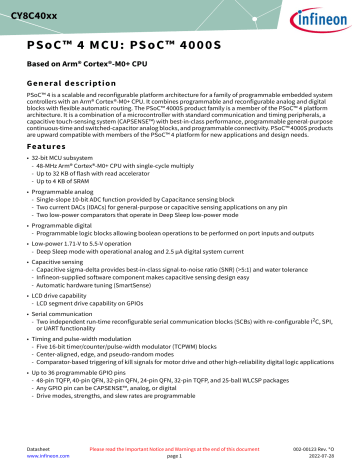3.5 Fixed function digital. Infineon CY8C4045LQI-S412, CY8C4045LQI-S413, CY8C4025AZI-S413T, CY8C4024LQI-S412, CY8C4025AZQ-S403, CY8C4024LQI-S403T, CY8C4025LQI-S412, CY8C4025LQI-S402T, CY8C4045LQI-S411, CY8C4024AXI-S412
Add to My manuals58 Pages
advertisement

PSoC™ 4 MCU: PSoC™ 4000S
Based on Arm® Cortex®-M0+ CPU
Functional definition
3.5
Fixed function digital
3.5.1
Timer/Counter/PWM (TCPWM) block
The TCPWM block consists of a 16-bit counter with user-programmable period length. There is a capture register to record the count value at the time of an event (which may be an I/O event), a period register that is used to either stop or auto-reload the counter when its count is equal to the period register, and compare registers to generate compare value signals that are used as PWM duty cycle outputs. The block also provides true and complementary outputs with programmable offset between them to allow use as dead-band programmable complementary PWM outputs. It also has a kill input to force outputs to a predetermined state; for example, this is used in motor drive systems when an over-current state is indicated and the PWM driving the FETs needs to be shut off immediately with no time for software intervention. There are five TCPWM blocks in the PSoC™ 4000S.
3.5.2
Serial communication block (SCB)
I
The PSoC™ 4000S has two serial communication blocks, which can be programmed to have SPI, I2C, or UART functionality.
2 C Mode : The hardware I 2 C block implements a full multi-master and slave interface (it is capable of multi-master arbitration). This block is capable of operating at speeds of up to 1 Mbps (Fast Mode Plus) and has flexible buffering options to reduce interrupt overhead and latency for the CPU. It also supports EZI2C that creates a mailbox address range in the memory of the PSoC™ 4000S and effectively reduces I 2 C communication to reading from and writing to an array in memory. In addition, the block supports an 8-deep FIFO for receive and transmit which, by increasing the time given for the CPU to read data, greatly reduces the need for clock stretching caused by the CPU not having read data on time.
The I
I 2
2 C peripheral is compatible with the I C Standard-mode and Fast-mode devices as defined in the NXP
C-bus specification and user manual (UM10204). The I modes.
2
2 C bus I/O is implemented with GPIO in open-drain
The PSoC™ 4000S is not completely compliant with the I 2 C spec in the following respect:
• GPIO cells are not over-voltage tolerant and, therefore, cannot be hot-swapped or powered up independently of the rest of the I 2 C system.
UART Mode : This is a full-feature UART operating at up to 1 Mbps. It supports automotive single-wire interface
(LIN), infrared interface (IrDA), and SmartCard (ISO7816) protocols, all of which are minor variants of the basic
UART protocol. In addition, it supports the 9-bit multiprocessor mode that allows addressing of peripherals connected over common RX and TX lines. Common UART functions such as parity error, break detect, and frame error are supported. An 8-deep FIFO allows much greater CPU service latencies to be tolerated.
SPI Mode : The SPI mode supports full Motorola SPI, TI SSP (adds a start pulse used to synchronize SPI Codecs), and National Microwire (half-duplex form of SPI). The SPI block can use the FIFO.
Datasheet 13 002-00123 Rev. *O
2022-07-28
advertisement
Related manuals
advertisement
Table of contents
- 1 General description
- 1 Features
- 3 Table of contents
- 4 1 Development ecosystem
- 4 1.1 PSoC™ 4 MCU resources
- 5 1.2 ModusToolbox™ software
- 6 1.3 PSoC™ Creator
- 7 Block diagram
- 9 2 Functional description
- 10 3 Functional definition
- 10 3.1 CPU and memory subsystem
- 10 3.2 System resources
- 12 3.3 Analog blocks
- 12 3.4 Programmable digital blocks
- 13 3.5 Fixed function digital
- 14 3.6 GPIO
- 14 3.7 Special function peripherals
- 15 4 Pinouts
- 17 4.1 Alternate pin functions
- 19 5 Power
- 19 5.1 Mode 1: 1.8 V to 5.5 V external supply
- 20 5.2 Mode 2: 1.8 V ± 5% external supply
- 21 6 Electrical specifications
- 21 6.1 Absolute maximum ratings
- 22 6.2 Device level specifications
- 27 6.3 Analog peripherals
- 32 6.4 Digital peripherals
- 36 6.5 Memory
- 37 6.6 System resources
- 41 7 Ordering information
- 43 8 Packaging
- 44 8.1 Package diagrams
- 49 9 Acronyms
- 53 10 Document conventions
- 53 10.1 Units of measure
- 54 Revision history